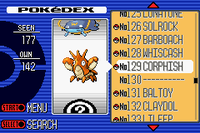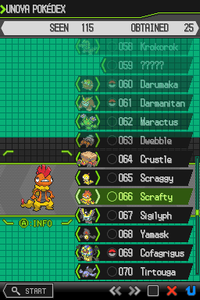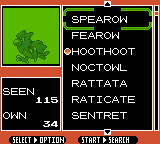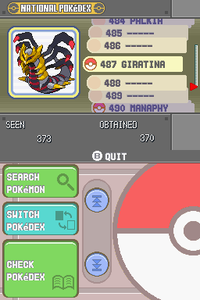Regional Pokédex
A regional Pokédex (Japanese: 地方図鑑 regional Pokédex) is a Pokédex order specific to a certain region of the Pokémon world. Rather than chronicle all known Pokémon as does the National Pokédex, a regional Pokédex serves to list those Pokémon native to the region.
Overview
A regional Pokédex usually starts with the Grass-type starter Pokémon and its evolutions, followed by the Fire-type starter and its evolutions, and the Water-type starter and its evolutions, then continuing through the rest of the Pokémon native to the region. Legendary Pokémon of the region are typically placed near the end, while the very last slot or few slots are occupied by special Pokémon not normally encountered.

A regional Pokédex will often place newly released evolutions and pre-evolutions near their base form, no matter how much distance is between them in the National Pokédex. For example, in the National Pokédex, Aipom falls at #190, with its evolution Ambipom at #424. In the Sinnoh region's Pokédex, however, they are #063 and #064, respectively. Capturing all Pokémon in a regional Pokédex will cause the Game Freak developers in-game to award the player with a diploma in Generation I, Generation II, and Generation III. Completing the National Pokédex awards another diploma in Generation III. In Generation IV, seeing every Pokémon in the Sinnoh region's Pokédex allows the player to receive the upgrade to National mode from Professor Oak. In later Generations, the Oval Charm and the Shiny Charm are awards for seeing and catching all non-Event Pokémon.
So far, only the Sinnoh region's original Pokédex does not naturally include all of the new Pokémon released in that generation. In Diamond and Pearl, new evolved species of Pokémon such as Gliscor and Leafeon were excluded from the listing, despite having been introduced in that game. This may have been because those Pokémon (and their pre-evolved forms) were not obtainable until after obtaining the National Pokédex in-game; however, it caused the odd outcome of many Pokémon new to Generation IV not being in any regional Pokédex at all. This was remedied in Platinum with its updated Sinnoh Pokédex, which added all new Generation IV-introduced evolutions as well as their relatives, leaving out only certain Legendary Pokémon. Generally regional Pokédexes are in the order of how the developers intend the player to meet the included Pokémon within the main game, except for the Kanto and Johto Pokédexes which do not seem to match this pattern.

List of regional Pokédexes
The Pokédex order for the nine main regions of the Pokémon world are as follows:
- Kanto Pokédex (RBYFRLG): #001 Bulbasaur - #151 Mew
- Kanto Pokédex (PE): #001 Bulbasaur - #153 Melmetal
- New Pokédex (GSC): #001 Chikorita - #251 Celebi
- Johto Pokédex (HGSS): #001 Chikorita - #256 Celebi
- Hoenn Pokédex (RSE): #001 Treecko - #202 Deoxys
- Hoenn Pokédex (ORAS): #001 Treecko - #211 Deoxys
- Sinnoh Pokédex (DPBDSP): #001 Turtwig - #151 Manaphy
- Enhanced Sinnoh Pokédex (Pt): #001 Turtwig - #210 Giratina
- Unova Pokédex (BW): #000 Victini - #155 Genesect
- Unova Pokédex (B2W2): #000 Victini - #300 Genesect
- Kalos Pokédex (XY)
- Central Kalos Pokédex: #001 Chespin - #153 Volcanion
- Coastal Kalos Pokédex: #001 Drifloon - #153 Moltres
- Mountain Kalos Pokédex: #001 Diglett - #151 Mewtwo
- Alola Pokédex (SM): #001 Rowlet - #302 Marshadow
- Melemele Pokédex: A subset of 120 of the Alola Pokédex's 302 Pokémon
- Akala Pokédex: A subset of 130 of the Alola Pokédex's 302 Pokémon
- Ula'ula Pokédex: A subset of 130 of the Alola Pokédex's 302 Pokémon
- Poni Pokédex: A subset of 100 of the Alola Pokédex's 302 Pokémon
- Alola Pokédex (USUM): #001 Rowlet - #403 Zeraora
- Melemele Pokédex: A subset of 150 of the Alola Pokédex's 403 Pokémon
- Akala Pokédex: A subset of 160 of the Alola Pokédex's 403 Pokémon
- Ula'ula Pokédex: A subset of 160 of the Alola Pokédex's 403 Pokémon
- Poni Pokédex: A subset of 130 of the Alola Pokédex's 403 Pokémon
- Galar Pokédex (SwSh): #001 Grookey - #400 Eternatus
- Isle of Armor Pokédex: #001 Slowpoke - #211 Zarude
- Crown Tundra Pokédex: #001 Snom - #210 Calyrex
- Hisui Pokédex (LA): #001 Rowlet - #242 Darkrai
- Paldea Pokédex (SV): #001 Sprigatito - #400 Miraidon
Comparison with other number systems
The National Pokédex includes all known Pokémon.
In the Pokémon Ranger series of spin-off games, Pokémon information is stored in the Browser, which acts similarly to a Pokédex for Pokémon Rangers. It is as follows:
- Fiore Browser: R-001 Bulbasaur - R-213 Mew
- Almia Browser: R-001 Pichu - R-267 Regigigas
- Oblivia Browser: R-001 Pidgey - R-301 Lugia
- Past Oblivia Browser: N-001 Piplup - N-222 Mew
In Pokémon Colosseum and Pokémon XD, the Strategy Memo acts as a Pokédex for Orre, listing Pokémon alphabetically.
Non-native Pokémon

|
This section is incomplete. Please feel free to edit this section to add missing information and complete it. Reason: Missing pre-Ndex info for all of Generation V and VI |
From Generation III onward, Pokémon not native to a region which are obtained (such as through trading) before a game's regional Pokédex has been upgraded to National Mode will be displayed with ??? as their Pokédex number in the status screen instead of a regional Pokédex number. If caught from the wild (through hacking the game), the Pokédex registration screen will display different numbers dependent on the game: Ruby, Sapphire, and Emerald display a number between 203 and 386, corresponding to the Pokémon's position in the National Pokédex minus those Generation I and Generation II Pokémon native to Hoenn (for example, Bulbasaur is the first Pokémon not in the Hoenn Pokédex so its number appears as #203, while Arbok is #226, but Pikachu, Raichu, Sandshrew, and Sandslash appear in the Hoenn Pokédex and are skipped, making Nidoran♀ #227). Pokémon FireRed and LeafGreen state only that the Pokémon's data has been registered, then skip straight to nicknaming the Pokémon, never displaying the Pokédex.
It is possible to store non-regional Pokémon from Ruby or Sapphire in Pokémon Box: Ruby and Sapphire without having acquired the National Pokédex, though their Dex numbers won't be shown. If a game with the National Pokédex is used with Box, Box's Pokédex Mode will be upgraded to the National Mode so non-regional Pokédex numbers will be displayed from then on, regardless of whether a Ruby or Sapphire player has acquired the National Pokédex or not.
Generation IV games instead display the registered Pokémon as #000 if it is outside of that game's regional Pokédex.
Pokémon Omega Ruby and Alpha Sapphire will display an empty Pokédex entry upon catching a non-native Pokémon.
In Generation VII games, due to the lack of a National Pokédex, non-native Pokémon that are caught will completely bypass the Pokédex, skipping straight to nicknaming; these Pokémon have no Pokédex numbers.
Trivia
- The first regional Pokédex of a generation usually, but not always, puts newly debuting Pokémon in the same order as the National Pokédex. Specifically:
- The Kanto, HoennRSE, UnovaBW, and AlolaSM Pokédexes all match the order exactly, with no exceptions. (For example, taking the Hoenn Pokédex order and removing the 67 Generation I and II Pokémon leaves 135 Pokémon that exactly match the National Pokédex order between Treecko and Deoxys.)
- The SinnohDP Pokédex matches when skipping over the Generation IV Pokémon in the National Pokédex that do not appear in the original Sinnoh Pokédex.
- The Kalos Pokédexes match if the Central, Coastal, and Mountain Pokédexes are joined in that order, except for the three Mythical Pokémon (which appear at the end of the Central Kalos Pokédex instead of the end of the Mountain Kalos Pokédex).
- The New (Johto) and Galar Pokédexes do not match the order. For example, Hoothoot (#015/#163) appears before Sentret (#019/#161) in the New Pokédex order but after it in the National Pokédex, and Blipbug (#010/#824) appears before Rookidee (#021/#821) in the Galar Pokédex but after it in the National Pokédex.
- Regional Pokédexes that do not debut at the beginning of a generation tend to not match the order, with the exception of HoennORAS and KantoPE. For example:
- The Sinnoh Pokédex expansion in Platinum puts Probopass (#156/#476) before Gallade (#160/#475).
- The JohtoHGSS Pokédex cannot match due to being based on the non-matching New Pokédex order.
- The UnovaB2W2 Pokédex puts Purrloin (#012/#509) before Lillipup (#022/#506).
- The AlolaUSUM Pokédex puts Poipole near the middle of the ordering.
- The Isle of Armor Pokédex puts Applin (#019/#840) before Chewtle (#056/#833).
- The Crown Tundra Pokédex puts Wooloo (#003/#831) before Skwovet (#005/#819).
In other languages
| |||||||||||||||||||||
See also

|
This game mechanic article is part of Project Games, a Bulbapedia project that aims to write comprehensive articles on the Pokémon games. |

